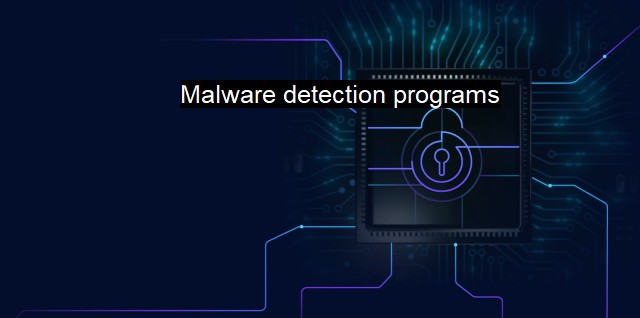What are Malware detection programs?
Effective Malware Detection Programs: Safeguarding Against Cyberattacks in Today's Threat Landscape
Malware detection programs are software applications that identify and eliminate malicious software, commonly known as malware. They function within the broader context of cybersecurity, fundamental to the elaborate defense system that keeps digital infrastructure and individual computers safe from diverse threats. This system deploys a multi-tiered strategy which entails identification, protection, detection, response, and recovery strategies. In the digital age, these cybersecurity strategies and specifically anti-malware programs, have become essential tools for securing digital ecosystems due to the rapid evolution of cyber threats.Malware is any software designed with malicious intent that causes damage to a device, server, or computer network. It covers a range of threats, including viruses, Trojan horses, worms, spyware, ransomware, and adware among other types. Each poses unique challenges and threats, necessitating regulators, lawmakers, IT experts, and individual users to constantly re-evaluate security protocols.
Malware detection programs fall broadly into two categories: signature-based scanners and behavioral-based scanners. The former meticulously scans the user’s machine, searching for specific sequences (or 'signatures') in code that match known malware. Their effectiveness depends on the completeness and relevance of their signature database, requiring regular updates. Behavioral-based scanners, on the other hand, monitor the system’s normal activities. If abnormal or disruptive activities are detected, they're isolated before they cause harm.
Advanced malware detection programs might utilize heuristics, artificial intelligence, machine learning, or sandboxes to detect, isolate or eliminate threats. Heuristic analysis scans a file for specific commands or instructions that may indicate malicious intent, even when the involved malware’s signatures are not present in the program’s database. Sandboxing is a unique, real-time function that tests the behavior of potentially harmful programs in a controlled and secluded virtual environment that mirrors the user’s system.
Malware detection programs are one element of a comprehensive cybersecurity strategy. They are typically at the front line of defense in protecting individual computers or networks, complemented by firewalls and intrusion detection systems. A firewall manages incoming and outgoing network traffic based on stated safety rules, whereas an intrusion detection system alerts users when it detects threats.
Advancements in technology used by the modern world have led to an increasing reliance on the digital landscape, generating a fertile ground for cybercrime. Therefore, the significance of incorporating malware detection programs is more important than ever. Whether on an individual or corporate scale, data breach, loss of vital information, or the encroachment on privacy carries disastrous consequences, economically and even socially. Hence, utilizing sophisticated anti-malware programs minimizes the risk of such security compromises.
With the proliferation of IoT (Internet of Things), the sphere of cybersecurity is no longer limited to traditional computers and networks. Now, it extends to interconnected smart devices like home security systems, thermostats, and even appliances. These IoT devices often lack the security features built into traditional computing systems, making them an easy target for cybercriminals. Therefore, an effective malware detection program must also secure devices within the IoT ecosystem much like it would for traditional systems.
The pursuit of cybersecurity is not just about equipment and software. It's also about creating the right security culture within an organization or among individual users. Proper training and education regarding safe digital behaviors, coupled with the right anti-malware programs, deliver the optimal defense against cyber threats.
Implementation of the latest and most effective anti-malware program forms an integral part of a strong cybersecurity strategy. Notwithstanding, the robustness of cyber threats underscores the need for continual vigilance, ongoing user education, and ever-evolving measures to keep our digital lives safeguarded. The combination of capable malware detection programs, sound cybersecurity strategies and practices ultimately forms the backbone of any robust cybersecurity protocol designed to combat increasingly sophisticated digital threats.

Malware detection programs FAQs
What is a malware detection program?
A malware detection program is a software tool designed to detect, prevent, and remove malicious software (malware) from a computer system. It uses various techniques to identify and block viruses, spyware, trojans, and other forms of malware in real-time.How does a malware detection program work?
A malware detection program works by scanning files, processes, and network traffic for known patterns and signatures of malicious code. It also uses behavioral analysis to detect new and unknown threats based on their actions and characteristics. Some programs also include features such as firewall protection, email filtering, and browser security to provide comprehensive protection against cyber threats.Can a malware detection program detect all types of malware?
No, a malware detection program cannot detect all types of malware. Some sophisticated malware uses advanced techniques such as rootkits and polymorphism to evade detection by traditional antivirus software. However, most malware detection programs use a combination of signature-based and behavioral-based analysis to detect and prevent the majority of common malware threats.Do I need a malware detection program if I already have an antivirus software installed?
Yes, you should have both a malware detection program and an antivirus software installed on your computer. While antivirus software is effective at blocking and removing known malware threats, a malware detection program can detect new and unknown malware by analyzing behavior and characteristics. Having both programs installed can provide comprehensive protection against cyber threats.| | A | | | B | | | C | | | D | | | E | | | F | | | G | | | H | | | I | | | J | | | K | | | L | | | M | |
| | N | | | O | | | P | | | Q | | | R | | | S | | | T | | | U | | | V | | | W | | | X | | | Y | | | Z | |
| | 1 | | | 2 | | | 3 | | | 4 | | | 7 | | | 8 | | |||||||